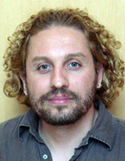Part 1 of 2 featuring Council Trainee Candidates
Edward Moreira Bahnson, Northwestern University
 |
| Edward Moreira Bahnson |
I started my scientific training working with Dr. Radi in the chemistry and biochemistry of reactive species. During my graduate work I focused on redox biology of the vasculature studying the biochemistry of cobalamin and reactive species in the endothelium. As a postdoctoral fellow, I have focused in the redox signals that drive the development of neointimal hyperplasia in the injured vasculature. I’m interested in the development of redox-based therapies for the inhibition of neointimal hyperplasia, as well as understanding the molecular mechanisms of the altered redox environment after arterial injury. In particular I’m interested in S-nitrosylation and NOX-dependent signaling.
Kim Dunham-Snary, Queen's University - Canada
 |
| Kim Dunham-Snary |
I am interested in how the mitochondrion, and specifically, mitochondrial DNA (mtDNA), influence susceptibility to disease. Known racial disparities exist for numerous pathologies including cardiovascular disease, metabolic diseases and even some cancers. Since the mitochondrial genome varies between geographical populations, it may be a substantial contributing factor to both the onset and severity of these and other pathologies. My previous work focused on mtDNA sequence variation and body composition as it relates to obesity and metabolic disease. My postdoctoral research will include investigating mtDNA structure and organelle dynamics in pulmonary arterial hypertension (PAH) and lung cancer.
 |
| Sam Giordano |
Sam Giordano, University of Alabama at Birmingham
My research interests include mitochondrial function and signaling, ROS, and inflammation in rat and pig models of vascular injury. Briefly, interleukin 8 (IL8) is upregulated during vascular injury and by overexpressing IL8 receptors on endothelial cells (ECs), and these ECs target to the sites of injury. Intravenous transfusion of the ECs overexpressing IL8 receptors into rat models have shown targeting to sites of injury, decreases in inflammatory cytokines and attenuation of vascular remodeling. Furthermore, we intend to determine the effects of alterations in the inflammatory cascade on ROS signaling and mitochondrial function during vascular injury.
SFRBM Members can click here to take part in the Trainee Council Election
— Published
Category: SfRBM Member Profile